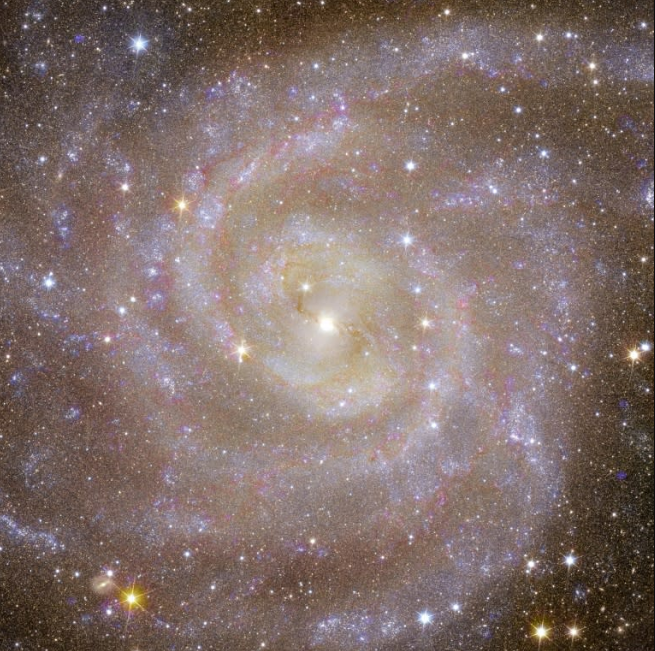The first images from Europe's Euclid space telescope were released on Tuesday, showing a nebula resembling a horse's head, never-before-seen distant galaxies and even "circumstantial evidence" of elusive dark matter.
Euclid blasted off in July on the world's first-ever mission aiming to investigate the enduring cosmic mysteries of dark matter and dark energy.
It will do so partly by charting one third of the sky — encompassing a mind-boggling two billion galaxies — to create what has been billed as the most accurate 3D map of the universe ever.
After joining fellow space telescope James Webb at a stable hovering spot around 1.5 million kilometres (more than 930,000 miles) from Earth, Euclid started sending back its first observations.
The first five images were unveiled during a press conference at the European Space Operations Centre in Darmstadt, Germany.
|
|
| A close-up shot of the image of the Perseus Cluster, which contains some galaxies 10 billion light years away that have never been seen before. Photo: AFP |
European Space Agency chief Josef Aschbacher praised the more than 3,600 people who contributed to the project, hailing "a milestone for European science and exploration".
ESA science director Carole Mundell said that the "exquisite images over vast areas of the sky taken very quickly to great depths with razor sharp precision" showed what Euclid was capable of.
They include a majestic shot of the nearby Horsehead Nebula, as well as spiral and "irregular" galaxies.
|
|
| The irregular dwarf galaxy NGC 6822, which is 1.6 million light years from Earth. Photo: AFP |
'Dark universe detective'
But Euclid project scientist Rene Laureijs told AFP that most exciting for the team was the image of the Perseus Cluster, a distant collection of more than a thousand galaxies.
Lurking in the background of the cluster is more than 100,000 additional galaxies, some of which are 10 billion light years away and have never been seen before, according to the ESA.
Jean-Charles Cuillandre, another scientist working on Euclid, told AFP that Euclid is different to other space telescopes because it takes in a very wide field of view, "like never before seen in the history of astronomy".
In comparison, the Webb telescope "looks at the sky through the eye of a needle," he said.
|
|
| Europe's space telescope Euclid is on a mission to explore the evolution of dark matter and dark energy in the universe. Photo: AFP |
This wide view means it can capture such broad images extremely quickly, without having to stitch together many different observations. The images released on Tuesday only took the telescope eight hours to capture.
The ESA has dubbed Euclid its "dark universe detective", charged with investigating why 95 percent of the universe appears to be made up of dark matter and dark energy, which we know very little about.
"Dark matter pulls galaxies together and causes them to spin more rapidly than visible matter alone can account for; dark energy is driving the accelerated expansion of the universe," Mundell explained.
Euclid's early images have already pointed towards "circumstantial evidence" of dark matter, according to Laureijs.
For example, he said it was "surprising" that Euclid did not spot stars trailing globular cluster NGC 6397, a collection of hundreds of thousands of stars.
"One of the theories is that there might be dark matter around the globular cluster, which keeps all the stars together," Laureijs said.
|
|
| Spiral galaxy IC 342 is also known as the "hidden galaxy" because it is normally partially blocked from our view by the disc of the Milky Way. Photo: AFP |
Cosmic rays, sunlight, X-rays
By capturing light that has taken 10 billion years to reach Earth's vicinity, Euclid also hopes to better understand how dark energy has driven the universe's expansion since the Big Bang 13.8 billion years ago.
Once Euclid has collected enough data, the scientists plan to plot out a 3D map — the third dimension being time.
Laureijs said the map would allow people to "walk through a part of the sky and go 10 billion years back in time".
But that will have to wait for future data releases over the planned six-year mission.
It has not been all smooth sailing for Euclid.
At first the software in the spacecraft's fine guidance sensor was "fooled" by cosmic rays, Laureijs said.
However the team on the ground uploaded new software to the spacecraft and "now it works flawlessly", Laureijs said.
There was also a problem with sunlight reflecting off a thruster boom which required rotating the telescope a little.
And particularly strong solar flares can sometimes project X-ray images of the spacecraft's sunshield, Laureijs said.
|
|
| The Euclid spacecraft pictured in February as it prepared to blast off to space on a mission to investigate dark matter and dark energy. Photo: AFP |
Euclid spacecraft operations manager Micha Schmidt said that there was nothing to be done about this last problem.
"We will lose three percent of the observations," he told the press conference.
Despite these "engineering challenges," Mundell declared that the mission had reached all its initial milestones and was now able to concentrate on the science.


























































